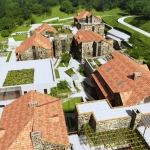In 12-14th centuries the cities of Medieval Armenia were flourishing. Trade was developing. With the development of ecclesiastical architecture, construction of secular buildings, especially of caravanserais was developing, too. This had a great importance for the development of the country, as it was providing the connection between cities and the quiet and regular motion of commercial caravans.
Caravanserais were usually located in the direction of main commercial roads, at a distance of a day which was about 40 kms. They were built in favorable places provided with water and free of blizzards and winds. There are preserved caravanserais not only in the Republic of Armenia, but also in different districts of historical Armenia and are half-standing or in ruins. Among important caravanserais of Medieval Armenia the most well-preserved and famous one is the Selim or Sulema Caranvanserai.
The caravanserai is built on the old road from Gegharquniq to Syuniq, which led to Iran from one side and to the valley of Qour from another side. It is situated on the boundary of the regions of Martouni and Yeghegnadzor, immediately on the top of the Selim mountain pass, from where opens a wonderful view to Sulemadzor and endless mountains of Vayots Dzor. The spring near the caravanserai provided it with water. It is interesting that at a distance of 8-10 kms, on the road to the village Lernantsq (Aghqend) there is a smaller caravanserai, which was connected with the difficult conditions of the road, especially during winters. On the walls of the caravanserai, which is built of basalt, there are two inscriptions – in Armenian and in Persian, where it is noted that it was built by the prince Chesar Orbelyan in 1332. The inscription in Persian is above the entrance and is a proof that this language had an international significance for commercial roads.
The building of the caravanserai is composed of three parts – a vestibule, a big three-nave hall and a chapel situated next to the vestibule. The only entrance to the caravanserai is from the vestibule and is decorated with stalactites and hautrelieves of animals. It is a small rectangular hall with windows decorated with stalactites. There is an oculus at the center of the ceiling. From the vestibule one can enter the big hall, which has a length of 26 ms and is divided into 3 naves by 7 pillars in 2 rows. Between the pillars there are stone troughs, and at one corner of the hall there is a basalt “gour” (pool) to provide animals with water. At the west edges of the hall there are rooms for the guides of caravans. The hall is covered with two-sided tiled roof and is lightened by 3 oculi. Selim caravanserai had an immense significance in the life of Medieval Armenia. Owing to its firm construction, comfortable halls provided with all necessary conditions, it was an important refuge for Armenian caravans and for those passing in Armenia.
The Medieval Shelter of Selim
Back To Top










